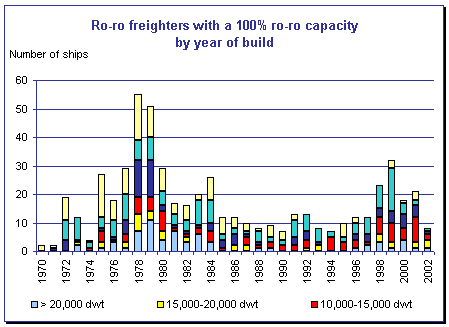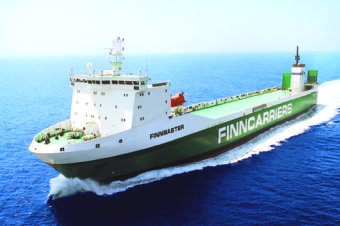
The Ro-ro market
in 2000
|
|
|
| |
| Searching for shelter |

|
|
The ro-ro ships are something of a niche market
within the mainstream liner-shipping sector, and their special
characteristics set them apart from the rest. Although the concept of
'roll-on / roll-off' is older than containerisation, within the
regular liner routes, they have been largely replaced by the latter.
Competition from the containerships was first felt on
the long-haul routes, and then spread itself to other areas where the
time at sea was preponderant over the time in port. Although this is not
a hard and fast rule, it underlines the sensitive ratio of the voyage
cost to the transit cost. A large proportion of the core ro-ro traffic
is protected from the competition of containers because of this
criterion, but they nonetheless have to comply with the exacting
requirements of shippers to whom the transit-time remains a predominant
factor. In order to meet this condition, ships have to be increasingly
fast, and this has resulted in a real split within the fleet.
However, while speed is a vital concern, it is not
the only yardstick used, especially in the trailers sector, where the
need is for vessels having a bigger loading capacity, but also being of
the right configuration to allow quick turnaround times in port.
1999 and 2000 were both difficult years for many
owners whose ships were not sufficiently specialised and who therefore
had difficulty finding employment. The charter market severely suffered
from the delivery of numerous newbuildings, ordered by liner-operators
who proved to be some of the most active players in the market. Pooling
and mergers among some of the large groups which led to fleet
rationalisations, also contributed towards making the market well and
truly depressed.
"Made to measure" seems to have been the
guiding force prompting a number of companies to order new vessels which
could fit precisely into their specific routing requirements, as for
many years such units were rarely available on the tramp market.
Although this has resulted in a well-needed renewal
of the fleet, at the same time it produced a considerable slowing-down
of activity in the spot market. We therefore have been confronted in
2000 with a two-tier market - between modern vessels ordered by owners
who had sufficient faith in their need, and older ones which for a large
number of them have become commercially obsolete.
The chartering market thus became very quiet, far too
quiet for many, and consequently very little long-term business was
seen.

|
| Ro-ro ships on long-hauls |

|
|
This sector of the market is extremely confined and
fragile, given the small number of vessels and actors. The combination
of several factors dealt a blow to these ships.
First, the delivery of several PCC and PCTC* have
gradually replaced, with a domino effect, certain large ro-ro ships
dedicated to cars and mixed cargoes. In addition, the consecutive
mergers of Nosac and Wilhelmsen, then the new group (Nosac Wilhelmsen
Lines) with Wallenius, have left their mark. This has resulted in no
fewer than seven big ro-ro ships being put back on the market, which
then remained, for the most part, idle for several months over the year.
Elsewhere, NSCSA which is leaning more and more towards
containerisation, took two of their vessels out of service, and have
been unable to find either employment or a buyer. The first three months
of the year therefore did not offer any option but to look for voyages
covering the displacement needs of various international organisations
and military authorities. However at year's end, some operators, in
view of the depressed state of the market, took the plunge to charter
out on a rather long-term period, but at rates averaging 25-30 % less
than those achieved a year ago. The vast majority of this tonnage is
best suited to business on the West African coast, where the ro-ro
concept is (still') accepted. In this respect, Grimaldi, Delmas, and
Setramar have signed new agreements starting in 2001 to form a
partnership on the Mediterranean / West African routes, where both large
combined ro-ros and mixed geared ro-ros will be used.
This type of vessel is rarely built nowadays, and
outside of Nosac-Wilhelmsen or even more Grimaldi, the fleet is to all
intents and purposes not being renewed. It should be pointed out that
the large vessels ordered in the last three years have virtually nothing
in common with the existing fleet, which has an average age of almost 16
years. The former are expensive ships, capable of more than 20 knots,
and built for dedicated routes combining both forest products and heavy
rolling material.
Others have a large car-carrying capacity but are
also equipped with cranes to be able to handle situations in certain
areas such as Africa which do not have the necessary port-handling
facilities.
 |
FINNMASTER
11,530 grt, blt 2000 by Jinling - Operated by Finncarriers
|
|
| Ro-ro ships in the trailer sector |

|
|
Over the course of the year, there has been a
noticeable split in the market ' based on the size and speed of the
vessels. There has been a sustained demand for ships which can be
classified as a 'new generation' (2,200 - 2,800 lane metres length,
20 knots or more), but on the other hand almost absent for older ships,
which have lower loading capacities and speeds, which seem to interest
nobody.
No one could foresee that vessels in the category
1,700 - 2,000 lane metres, capable of 17-19 knots, would have the
dickens of a time to find employment throughout the year. Many of these,
idle for weeks on end, did occasional trips transporting military
equipment or as a last resort did temporary fill-in voyages for some
line-ships. The rates that they were able to get were considerably below
the previous year, in the order of 30-40 % less.
The undeniable tendency of the vast majority of the
main liner-operators over the last two or three years has been to order
new ships or to charter-out for long-term periods (often three to five
years) against these newbuildings. Gradually the delivery of these new
vessels has had the knock-on effect of putting back on the market units
which had previously been chartered-out. Many people anticipated a
revival in the chartering market as a direct consequence of seeing these
ships come back onto the market. The market's reaction was
unfortunately quite the opposite and demand remained negligible.
Often when the market is at its depths for a long
period, new line projects rear their head, and newcomers start to try
their hands in view of the attractive rates. Nonetheless, the repeated
attempts of such initiatives have frequently fallen flat, and
unfortunately such was the case this year. One should however look
carefully at the development of some liner business which is dreamed up
to provide an alternative to the overloaded roads. The quality of
service offered, the efficiency of the ships used, and the subsequent
involvement of road-hauliers in the projects, are all elements that seem
essential to us to ensure their success. But in time, such new
developments should come about.
The big merger between Tranfennica and Finnlines
finally collapsed at the end of the year, just as it seemed on the point
of being concluded. This combined force would have resulted in the
largest single owner, in terms of units, within the ro-ro fleet. It is
highly probable that we shall see in the coming years, as in other parts
of the shipping industry, a trend towards consolidation, enabling
players to benefit from large economies of scale, which is becoming
indispensable in today's competitive climate.

|
|
In total contrast to the containership market, very
few new generation ro-ro vessels can be found for tramping. On the other
hand, as the graph on the age structure of the current fleet shows, it
strikes us as of prime importance that the pace of scrapping should be
accentuated in order to get to the root of the problem. Whilst there has
been a successful renewing of the fleet at the top, there is a pressing
need to balance this out by cutting back some of the oldest units, which
apart from age are totally obsolete both technically and commercially.
Scrappings have in fact increased in 2000, with 28
ships demolished and four others sold for conversion, totalling 275,000
dwt, compared to 10 ships and 59,000 dwt in 1999. The cable-laying
market is still interested in sturdy ro-ro ships with a forward
superstructure, which are excellent bases for conversion. The sale of
such ships over the last two years for this purpose has at least allowed
them to obtain a better price than the traditional market would have
offered at the same time - namely scarcely above the scrap value.
If we exclude ro-pax ships, among the 51 ro-ro ships
delivered in 1999 and 2000 (respectively 32 and 19), around 40 units
were employed by their owners, and 10 were placed on long-term charters.
These figures illustrate what we have previously pointed out, namely
that there are precious few vessels left purely for tramping.
We do not foresee a sudden revival in the chartering
market in 2001, in terms of the volume of business. However, provided
that scrapping levels remain sufficiently high, owners with good quality
ships should logically be able to profit from an improvement in rates,
especially as the number of newbuildings to be delivered in 2001 will be
equivalent to 2000 (with around 20 vessels) but far below the 1999 level
(of more than 30 units).
|
Shipping and Shipbuilding Markets in 2000
I N D E X
|